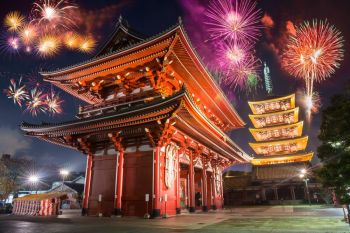
Witajcie!
Dzisiaj będziemy mieć zajęcia angielsko-polskie na bardzo ciekawy temat, a mianowicie JAK JAPOŃCZYCY OBCHODZĄ NOWY ROK?
Lekcja skierowana jest dla wszystkich zainteresowanych wychowanków, a w szczególności dla moich grup wychowawczych oraz uczniów, którzy uczęszczają do mnie na koło zainteresowań z języka angielskiego pt. "English In Use" (uczniowie wytypowani do wyjazdu z programu Erasmus+).
JAPANESE CULTURE
1. Na początku proszę Was o obejrzenie filmiku w języku angielskim z napisami w języku polskim.
Temat: How Japanese celebrate New Year? - JAK JAPOŃCZYCY ŚWIĘTUJĄ NOWY ROK?
Skopiuj link do przeglądarki internetowej. Włącz film.
https://www.youtube.com/watch?v=8iqejlGKHCM&feature=youtu.be
2. Teraz proszę odsłuchać nagranie tekstu, który znajduje się poniżej. Następnie rozwiąż quiz. Powodzenia!!
Skopiuj link do przeglądarki internetowej. Odsłuchaj nagrania
http://dreamreader.net/lesson/new-years-day-in-japan/
For a long time, New Year’s Day in Japan has been a very special day. It is so special that everyone in the country used to celebrate their birthday at the same time on this day!
There are many customs about New Year’s Day that Japanese people follow. Many people will watch the sun rise on New Year’s Day. They want to see the first sun of the first day of the year as it comes up in the sky. Early in the morning, people gather on the beaches and wait for the sunrise. Some people pray to the sun.
Another tradition is to go to a temple. Throughout the day, people go to a local shrine or temple and pray. They usually pray for good health or happiness. Many people buy a slip of paper called an “omikuji”. This tells people their fortune and whether they will have good luck or bad luck in the future. After reading the omikuji, it is a custom to fold it around the branch of a tree.
Of course, there is some special food to be eaten on this day! People either prepare or order a box with food called “osechi”. All of the food in the box has a special meaning. For example, the fish cakes in the osechi are shaped like the sun and give good luck. The black beans called “kuromame” are a wish for health. Many people also eat “mochi”, which is a soft rice cake. Osechi and mochi boxes are huge and can be eaten over two or three days. By the way, the most expensive osechi meal ever sold was $233,000 in 2011. This is because the box was made of gold!
Rozwiąż Quiz (zaznacz poprawną odpowiedź).
Nowadays, everyone in Japan celebrates their birthday on New Year's Day.
- True
- False
Many people in Japan go to a beach and watch the sun rise on New Year's Day.
- True
- False
Where do people go to buy an omikuji?
- a beach
- a store
- a temple
- a mall
What does the kuromame in osechi mean?
- a wish for good luck
- a wish for health
- a wish for money
- a wish for happiness
The most expensive osechi set cost about 233,000 yen.
- True
- False
Mam nadzieję, że Wam się podobały zajęcia!
Pozdrawiam,
Martyna Wójcik (gr. III, IV)
